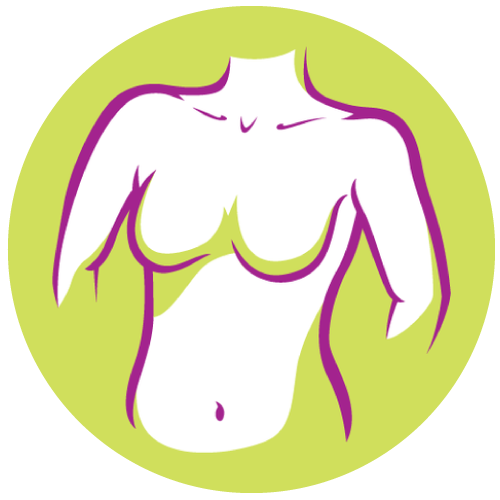Bra Fitting Guide
For those of us with breasts on our chests, bras are often a daily piece of apparel that play a huge role in both style and comfort. Have you ever truly taken the time to make sure your bra fits well? If the answer is no - what are you waiting for? A poor-fitting bra can leave you with chafing or squeezing in all the wrong places, back or neck pain, and a lack of support as you go about your day. Taking the time to find the right fit for your body can help you feel great in your clothes and stay healthy.
We know that no two bodies are the same, and that’s why we prioritize helping you find your perfect fit from our line of supportive, luxurious bras. Bras are complex, highly engineered garments, and you could blindly try on 100 varieties searching for just the right one. Our professional bra fitting sessions eliminate the need for this frustrating process by helping you discover which size and style will help you feel comfortable and confident in what you’re wearing.
Bra Sizes Explained
Most commonly, bra sizes are listed using a letter and number system that represent your bust and band size. In essence, the cup size (letter) and band size (number) reflect your bust and ribcage measurements, respectively. You measure your bust at its fullest point, measure your rib cage, do a little math and… voila! You have the golden letter + number combo that should lead you to the right fit. But... it’s really not quite as simple as that.
What you’re looking for in a perfect fit:
-
The cups fully encompass your breasts with no gaps or wrinkling.
-
The band is low and firm, staying parallel to the floor and snug on the loosest hook (when brand new).
-
The center piece between the cups is flush against your sternum.
-
The straps pull the cup flat but don’t “dig in.” You can fit about two fingers between your shoulder and the strap.
-
The wing (side) of the bra is helping to push breast tissue forward into the cup.

Finding your best-fitting bra requires more than just one measurement. Breast shape plays a huge role in finding both the right size and style of bra for your body, and identifying existing issues you have with an ill-fitting bra can guide you to making the correct adjustments. That’s why bra sister sizes, as explained in the chart below, are crucial to finding your correct fit.

Bra Size Chart
As you’ll see in this size chart, all bras have what’s called a “sister size.” These sister sizes are corresponding sizes to your actual measurements. For example, let’s say your measurements give you a bra size of 34C. You try on a 34C, and the cups fit well but the band feels tight. Though it’s a little non-intuitive, the solution is not to just try a 36C - that bra will actually be one cup size bigger. You’ll instead need to find your sister size on this chart (in this case, that would be a 36B).
If you need a smaller or larger band, look to the right or left of your original size suggestion for the right sister size. If you need a smaller or larger cup size, move up and down the column with your band size. As you take things like breast shape into account, you may also need to try wearing the same size in a different bra style.
It’s important to note that our sizing is based on the UK size scale system, so you will likely wear a different size in our shop than most other places you’ve gone before. But no need to worry – we’re ready to help you navigate and understand what Curvaceous size will work for you.
Breast Shapes
Breasts are wonderfully unique parts of our bodies, and you can accentuate your natural shape by selecting the right bra. Too often, we meet people who are not only wearing the wrong size bra, but are attempting to conform their breasts into a bra style that just isn’t right for their body. We’re here to help you discover how you can best support your breast shape and look great while doing it!
Let’s take a look at a few common breast shapes. If you don’t think you see your body represented here - don’t worry! Our fitting specialists are experts at helping you identify a style that complements your breasts, without making you feel awkward or uncomfortable. Our goal is to empower you to look and feel your best.

1. Equal & Even (formerly “average shape”)
Neither too full or shallow on the top, bottom, or sides, your breasts have a pretty consistent shape all-around with tissue evenly distributed.

2. Shallow
With much less breast tissue at the top than the bottom, your breasts can be almost flat or look like a ski jump from the side. This can be the result of weight loss or nursing, or just be your natural shape. Your breasts typically do not fill out the top of a traditional bra cup.

3. Asymmetric (formerly “unequal”)
One breast is larger, fuller at the neckline, or set higher on the chest wall than the other. Many of us don’t have perfectly symmetrical breasts, though the difference may be more pronounced for some.

4. Fuller on the Sides
If you have breasts in this shape, your breast tissue may interfere with your arms’ range of motion. Sometimes, you may notice that your chest looks wider than it actually is or see tissue splaying to the side.

5. Fuller in the Middle
Your breasts tend to fall out of the middle of bras or may form a bubble at the center above the neckline (but not on the sides). Note that breasts that are full in the middle are not the same as narrow set breasts, which touch or almost touch without a bra.

6. Fuller on Top
This shape describes breasts that are very round and full with or without a bra. You may have had problems in the past with your breasts bubbling over the top of bras that fit poorly.

7. Pendulous
Breast tissue that has aged, been through nursing children, or gone through significant weight fluctuations tends to take this shape (but not always). When your breasts are placed in a bra, the cups usually fill out on top.

8. Wide Set
Your breast root itself is wide set on the chest. A decent amount of space is present between your breasts in the middle.

9. Narrow Set
The opposite of wide set, your breasts are very forward facing with not a lot of tissue on the sides.

10. Narrow Shoulders
You may have narrow shoulders if a vertical line drawn from where a bra’s wire or cup stops beneath your arm would hit the very tip of your shoulder or go past the outside of it. You may experience the need to constantly pull up slipping straps.

11. Low on Chest Wall
You can see a lot of space from the top of your shoulder to where your breast tissue begins. Sometimes people with this breast shape have experienced straps not being long enough to fit well.

12. High on Chest Wall
There is very short distance from the top of your shoulder to where your breast tissue begins. You may have had issues with bra straps being too long or cups and wires digging into your armpit due to lack of space.

13. Centered on Chest Well (formerly “average set”)
Your breasts appear neither high nor low on your chest vertically, nor too close or wide across.
Types of Bras
Along with accurate sizing, finding the style of bra that works best for your breasts is essential. Different types of bras provide different support and fit options, and your Curvaceous fitting specialist can help recommend which type you should be wearing for the most comfort and a flattering appearance.
There is also a time and a place for each type of bra. Your closet may not be complete without an everyday t-shirt bra, sports bra for exercise, and strapless bra for certain shirts or dresses. Experimenting with how each style fits your breasts can help you determine which size you’ll need in each different type listed below.

Balconnet
A balconnet bra offers slightly less coverage than a full cup and includes wider set straps to accentuate your natural cleavage. This style is often a great choice for people with larger breasts.

Full Coverage
Excellent coverage and support come from full cups and closer-set straps. This style helps many people feel secure in their bra and can be good option for those who often struggle with straps sliding off.

Plunge
With less coverage in the center and a slight lift from the sides, plunge bras are great for V-neck or lowcut clothing. Angled cups help eliminate issues with gaping and give your breasts a comfortable lift without extra padding.

Sport
Move with confidence by choosing a well-designed, secure sports bra made for action. These bras as meant to hold your breasts close to your chest and minimize movement when exercising.

Strapless
A great choice for outfits where you’d prefer to not show off your bra straps. Great strapless bras are designed to provide support without slipping, ensuring that your bra never holds you back from wearing what you want.

T-shirt
Designed to be invisible under your t-shirt (hence the name), these bras are excellent for everyday wear. They can be molded, wireless, or include underwire depending on the style, giving you plenty of choices for the perfect fit.

Wireless
While wireless bras may not offer as much support as a bra with underwire, they can provide a comfortable, smooth fit for many breast shapes. Wireless bras certainly have their advantages as a casual option for people who don’t like the feel of underwire.
Bra Fittings
Remember that different bra manufacturers have different sizing guidelines, so a professional fitting is always recommended to find your correct size and fit. At Curvaceous, our bra fitting experts will help you find your best fit based on your unique breast size and shape. Our goal is to help you feel comfortable, both at your fitting and after you leave our store by providing respectful service and high-quality bras that perfectly complement your body shape. Let us help you make your breasts happy and get dressed each day with confidence.
